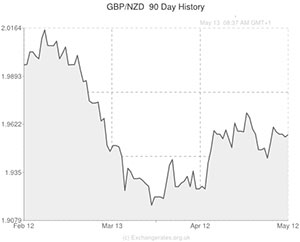
A lack of pertinent economic data for New Zealand and the UK left the GBP to NZD pairing trading in a fairly narrow range, however the ‘Kiwi’ experienced modest movement as a result of global economic developments.
In the immediate aftermath of the publication of Chinese industrial production and retail sales figures, the commodity-driven New Zealand Dollar slipped against rivals like the Pound.
China’s retail sales climbed by 11.9 per cent in April, year-on-year, rather than gaining by the 12.2 per cent expected.
Meanwhile, industrial production in the world’s second largest economy eased from +8.8 per cent to +8.7 per cent. Economists had been projecting an 8.9 per cent annual increase in output in April.
The data added to the argument for China’s government introducing additional stimulus.
In the view of one Shanghai-based economist; ‘The slowdown in economic growth is unchecked and the data reflects pretty weak fundamentals of the economy. Stocks will continue to suffer as investors are concerned whether the government will take additional measures to bolster growth on top of increasing infrastructure spending.’
However, the New Zealand Dollar largely recovered losses prior to today’s domestic retail sales (excluding inflation) figures.
The New Zealand sales report is expected to show a 0.9 per cent increase in the first quarter, quarter on quarter, following a gain of 1.2 per cent in the final three months of last year.
Domestic food price data had little impact on the ‘Kiwi’.
New Zealand’s food prices climbed by 0.6 per cent in April month-on-month, wiping out the 0.3 per cent decline recorded in March. An increase in the cost of dairy products and eggs was partly responsible for the climb.
According to economist Christina Leung; ‘The low level of food price inflation, along with the effects of the high New Zealand Dollar on other areas of tradable inflation, are contributing to the overall contained inflation environment. We expect rising inflation pressures will become more apparent next year when the dampening influence of the high New Zealand Dollar lessens, and economic activity ramps up and underpins a lift in underlying inflation.’
During European trading the ‘Kiwi’ was treading water against Sterling and the ‘Greenback’ as investors hold fire before the publication of this week’s influential economic reports.
While today’s US advance retail sales report could inspire widespread fluctuations in the currency market, movement in the Pound to New Zealand Dollar exchange rate will be restrained until UK employment figures either confirm or defy expectations for a decline in the British jobless rate.
If tomorrow’s report does show that the UK unemployment rate eased to 6.8 per cent the Pound could rally against the New Zealand Dollar.
New Zealand Dollar (NZD) Exchange Rates
[table width=”100%” colwidth=”50|50|50|50|50″ colalign=”left|left|left|left|left”]
Currency, ,Currency,Rate ,
New Zealand Dollar, ,US Dollar,0.8628,
,US Dollar,0.8628,
New Zealand Dollar, ,Euro,0.6266,
,Euro,0.6266,
New Zealand Dollar, ,Australian Dollar,0.9237,
,Australian Dollar,0.9237,
New Zealand Dollar, ,Pound Sterling,0.5114,
,Pound Sterling,0.5114,
US Dollar, ,New Zealand Dollar,1.1595,
,New Zealand Dollar,1.1595,
Euro, ,New Zealand Dollar,1.5954,
,New Zealand Dollar,1.5954,
Australian Dollar, ,New Zealand Dollar,1.0822,
,New Zealand Dollar,1.0822,
Pound Sterling, ,New Zealand Dollar, 1.9556,
,New Zealand Dollar, 1.9556,
[/table]

Comments are closed.